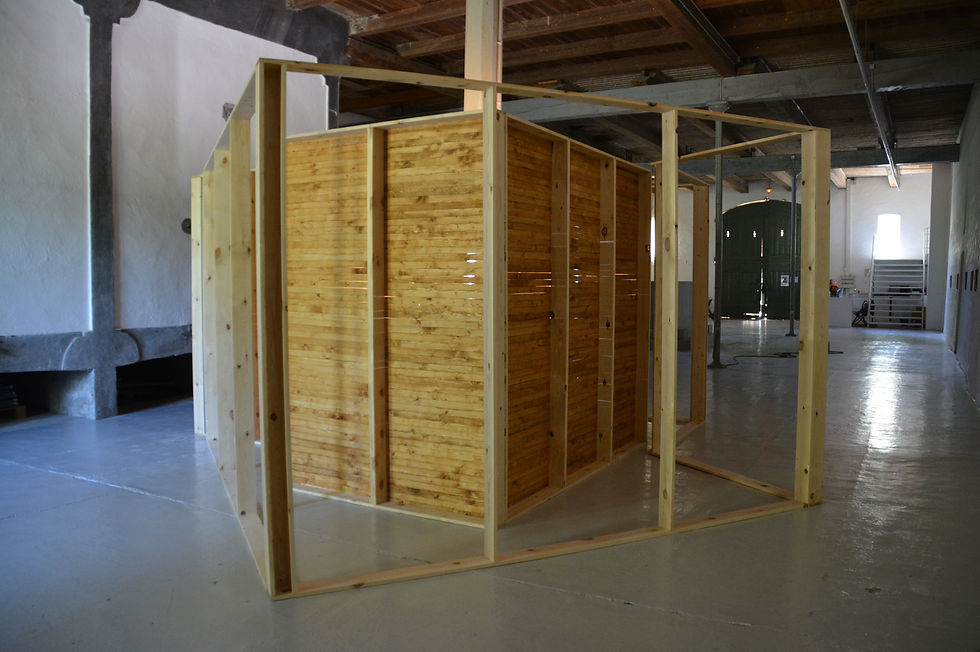


At first glance, I am imposing me on you and you are on me presents itself as an abstract architectural structure: a large-scale installation composed of open and closed wooden frameworks. Its form is ambiguous, yet familiar. The dimensions, materiality, and constructive logic evoke the framework of domestic architecture—the skeletal blueprint of rooms in the making. However, the installation denies easy spatial interpretation. It resists function and dissolves clarity.
Upon closer inspection, two interlocking yet distinct room-like structures emerge—let us designate them, for the sake of analysis, as Room A and Room B. These two configurations, while spatially interwoven, retain their own identity.
Where the frameworks intersect, the installation is closed off—boarded up and visually inaccessible to the viewer. This act of concealment functions symbolically: we are both drawn into and excluded from the intimate core of the work. The sense of partial access echoes dynamics of interpersonal connection—where proximity does not always entail understanding.
The title, I am imposing me on you and you are on me, explicitly foregrounds the work’s relational dimension. It invites a reading of the installation not simply as a spatial proposition, but as an embodied metaphor for human interaction—particularly the tension between autonomy and intimacy. The use of personal pronouns—I and You—suggests that the work stages a private negotiation, potentially autobiographical, but resonant on a universal psychological plane.
Conceptually, the installation operates as a three-dimensional Venn diagram—a visual representation of overlapping yet distinct entities. Originating in the late 19th century with British logician John Venn, these diagrams are used to map logical relationships between sets, often in disciplines such as mathematics, linguistics, and logic. Vansteenkiste transposes this abstract tool into sculptural language. The two “rooms” do not collapse into one another; they retain their formal uniqueness. But they also create a third zone—an interstice, a liminal shared space—symbolically charged with intimacy and complexity.
This shared zone can be interpreted as a spatial analogue for what psychoanalyst Donald Winnicott termed the “holding environment”: a transitional, nurturing space that allows for psychological development and emotional safety within human relationships. In this sense, Vansteenkiste’s installation becomes a diagram of emotional architecture—a map of how two subjectivities navigate shared experience while preserving their own contours.
Although deeply rooted in the artist’s personal history and relational experience, the work transcends autobiography. It invites reflection on the basic paradox of all human connection: that we are never fully merged, never entirely separate. We build structures—emotional, architectural, symbolic—to mediate this paradox.
I am imposing me on you and you are on me is not only a sculptural meditation on space, but a philosophical inquiry into the architecture of intimacy. It visualizes the push and pull, the enmeshment and distance, that defines the relational fabric of human life.
For M



a special thanks to:
Joël Schuurmans
Wesley Meuris
Pieter Vermeulen
Hanne Van Dyck
Anouk De Clercq
Samuel Saelemakers
Angela Serino
Stef van Bellingen
Michael Vandewalle
Niekolaas Johannes Lekkerkerk
Hilde Van Pelt
Luc Vints
Layla Moget
Lieu d'Art Contemporain (LAC) de Sigean
Christine Clinckx, Stijn Cole, Ronny Delrue, Cel Crabeels, Renato Nicolodi
curator: Christa Vyvey
Made possible by:
